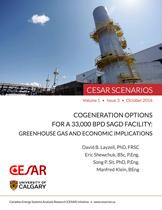To address concerns about climate change, and regain public support for Alberta’s oil production to access markets, the Alberta government has been developing policies and regulations aimed at reducing greenhouse gas (GHG) emissions. In addition to carbon taxes, energy efficiency programs and a 100-million-tonnes cap on oil sands emissions, the government has committed to eliminate coal power emissions from the Alberta electrical grid by 2030 and replace two-thirds of coal’s present day capacity with renewables. To achieve climate change goals, the envisaged changes in technologies and practices have tended to be focused on individual industrial sectors.
Cogeneration – or the simultaneous generation of electricity and industrial heat, is an example of a technology that can transcend sectorial boundaries, increase system level efficiency and reduce overall GHG emissions. At oil sands Steam Assisted Gravity Drainage (SAGD) facilities, cogeneration can produce the required steam and power for oil sands production, and provide additional power to the public grid of Alberta. This report is the first of two studies that explore the technical, environmental and economic implications of integrating large-scale changes in the electricity sector with changes in the heat and power generation technologies used by SAGD to produce oil sands crude.
Read online
Cite this document
To cite this document: Layzell DB, Shewchuk E, Sit SP, Klein, M. 2016. Cogeneration options for a 33,000 BPD SAGD facility: Greenhouse gas and economic implications. CESAR Scenarios Vol. 1, Issue 3: 1-54.

